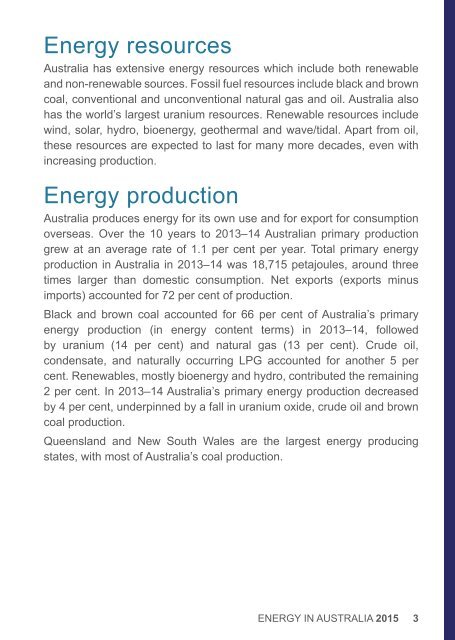Energy in Australia
Energy-in-Australia-2015
Energy-in-Australia-2015
Create successful ePaper yourself
Turn your PDF publications into a flip-book with our unique Google optimized e-Paper software.
<strong>Energy</strong> resources<br />
<strong>Australia</strong> has extensive energy resources which <strong>in</strong>clude both renewable<br />
and non-renewable sources. Fossil fuel resources <strong>in</strong>clude black and brown<br />
coal, conventional and unconventional natural gas and oil. <strong>Australia</strong> also<br />
has the world’s largest uranium resources. Renewable resources <strong>in</strong>clude<br />
w<strong>in</strong>d, solar, hydro, bioenergy, geothermal and wave/tidal. Apart from oil,<br />
these resources are expected to last for many more decades, even with<br />
<strong>in</strong>creas<strong>in</strong>g production.<br />
<strong>Energy</strong> production<br />
<strong>Australia</strong> produces energy for its own use and for export for consumption<br />
overseas. Over the 10 years to 2013–14 <strong>Australia</strong>n primary production<br />
grew at an average rate of 1.1 per cent per year. Total primary energy<br />
production <strong>in</strong> <strong>Australia</strong> <strong>in</strong> 2013–14 was 18,715 petajoules, around three<br />
times larger than domestic consumption. Net exports (exports m<strong>in</strong>us<br />
imports) accounted for 72 per cent of production.<br />
Black and brown coal accounted for 66 per cent of <strong>Australia</strong>’s primary<br />
energy production (<strong>in</strong> energy content terms) <strong>in</strong> 2013–14, followed<br />
by uranium (14 per cent) and natural gas (13 per cent). Crude oil,<br />
condensate, and naturally occurr<strong>in</strong>g LPG accounted for another 5 per<br />
cent. Renewables, mostly bioenergy and hydro, contributed the rema<strong>in</strong><strong>in</strong>g<br />
2 per cent. In 2013–14 <strong>Australia</strong>’s primary energy production decreased<br />
by 4 per cent, underp<strong>in</strong>ned by a fall <strong>in</strong> uranium oxide, crude oil and brown<br />
coal production.<br />
Queensland and New South Wales are the largest energy produc<strong>in</strong>g<br />
states, with most of <strong>Australia</strong>’s coal production.<br />
ENERGY IN AUSTRALIA 2015 3


